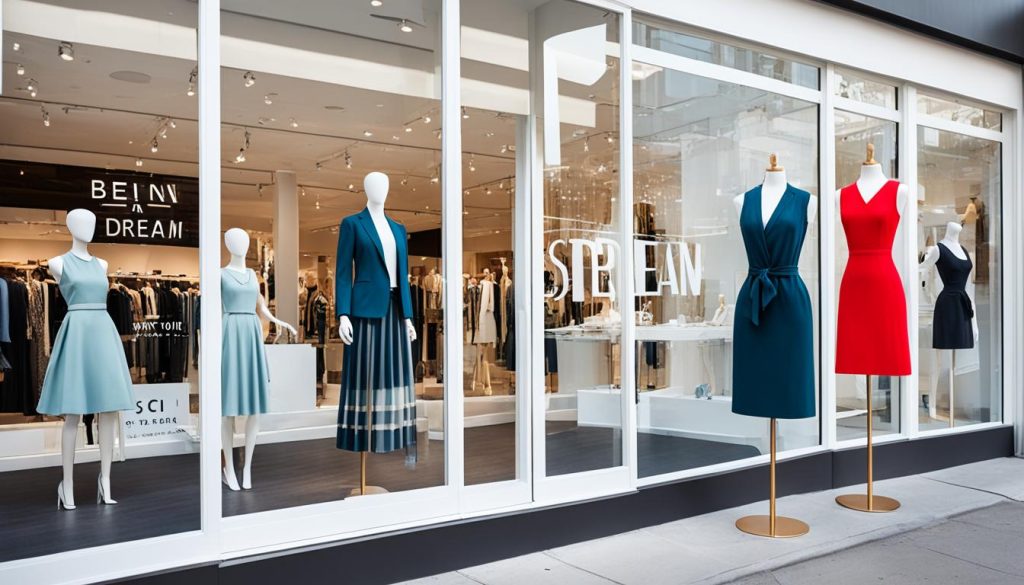Opening a boutique combines adventure with a love for trends. It lets you offer unique items to your customers, making you stand out. For success, planning is key. It involves market studies and understanding what customers want. You also need to develop a unique brand.
Following a guide to start a boutique will shape your idea. This ensures your products match the current market demand. Paying close attention to these details can turn your venture into a successful business.
The State of Boutiques in 2024
The boutique industry keeps changing in today’s fast-paced retail world. Economic shifts and new shopping habits are vital factors. They shape the market. They push businesses to innovate and adapt. Knowing the current retail trends helps anyone in the boutique industry.
Current Trends
Retail trends in 2024 favour unique and personal shopping things. People love local and handmade goods more and more. This love helps boutiques grow. Also, we see more blending of shopping online and in stores. Boutiques are catching onto e-commerce to get more customers.
Consumer Behaviour
In 2024, shoppers like to save money but still want special items. This is good for boutiques that sell unique products. Shoppers also prefer goods that are sustainable and ethically made. This trend is shaping what modern boutiques offer.
Revenue Insights
The boutique sector is growing steadily in 2024. Retail revenue figures are looking up. Despite ups and downs in the economy, boutiques stay strong. They do this by selling unique items in person and online. A strategy that mixes in-store and online sales is key. It helps boutique owners keep making money.
Deciding What to Sell in Your Boutique
Choosing the right products for your boutique involves balancing your passion with market demand. It’s key to take a strategic approach. This ensures your boutique stands out and meets what customers want.
Understanding Market Demand
Start with thorough market demand analysis. This means exploring what consumers want, current trends, and finding market gaps your boutique can fill. Knowing what is in demand helps you tailor your products to attract and retain customers.
Conducting Market Research
Thorough market research for your boutique is vital. Consider hiring firms or using online tools to understand consumer preferences and the competitive landscape. Explore existing boutiques to see what sells well and where there are gaps. Customer feedback is also very useful.
Choosing Your Product Range
With insights from market research and analysis, you’re ready to create a product range strategy. Choose products that speak to your audience and showcase your boutique’s brand. Items that meet market needs and highlight uniqueness will make your boutique stand out.
Sourcing Inventory for Your Boutique
Finding the right inventory is key to a successful boutique. Unique products make your store stand out. Look into different ways to source items, each with its own benefits and drawbacks.
Working with Wholesalers
Wholesale partnerships are very effective. They let you buy in bulk, saving money. Strong relationships with wholesalers mean better deals and unique products that reflect your store’s style.
Partnering with Designers
Working with designers offers exclusive, high-end products. This option brings special items that boost your store’s charm. Despite higher costs, unique designs attract customers who look for quality and distinction.
Exploring Trade Shows
Trade shows are great for finding new items and suppliers. They let you see the latest trends and build useful contacts. This real-life experience helps you choose the right stock and develop valuable partnerships.
Considering Dropshipping
Dropshipping is a budget-friendly choice. It’s great for online shops because it cuts the need for stock. But, you need a good online system to manage orders and keep customers happy.
Each method offers a way to create an appealing and unique product range. They can be adapted to suit your business, delighting your customers.
Choosing the Perfect Location for Your Boutique
Finding the right spot for your boutique is key. Picking a place where many people pass by can really help. We’ll look into what makes a spot great and why busy areas are good.
Factors to Consider
When choosing a boutique location, important things must be looked at. Check how many people walk by as more footfall means more potential customers. It should be easy to get to, close to public transport, or have enough parking. Also, being near businesses that complement yours can bring more people in.
High Foot Traffic Areas
Shops in busy areas stand out more to people walking by. Yes, these spots might cost more to rent. But, the many people passing by could mean you spend less on ads. Setting up in a lively place attracts lots of different customers without much advertising.
Designing Your Boutique’s Interior
Creating an engaging interior for your boutique is key to bettering the shopping experience. It helps to build a strong brand identity. A space that captivates customers can increase loyalty and boost sales.
Creating Visual Appeal
Visual appeal is crucial in boutique interior design. The right lighting, colours, and furniture make the space welcoming. These elements encourage shoppers to look around. Techniques like focal points and themed displays make your store stand out and memorable.
Implementing Brand Elements
It’s vital to weave your brand’s look throughout the store’s design. Use your logo, custom signs, and signature colours wisely. These elements bring a consistent and professional vibe. They connect more deeply with your customers.
Effective Display Strategies
Good display tactics boost sales. Think about product placement and using mannequins for outfit ideas. Put items with high profit margins where people can easily see them. Seasonal displays keep your store looking new, making customers come back. A successful strategy presents merchandise attractively, encouraging purchases.
Understanding Your Target Market
Knowing your boutique’s target market is key for shaping product lines and marketing plans. This insight makes it easier to pick products and create ads that catch the eye. Your store will stand out in a busy market by knowing who your customers are.
Identifying Your Ideal Customer
Finding your perfect customer starts with making a detailed profile. Consider their age, gender, interests, how much they earn, and shopping habits. Knowing these details helps boutique owners match their goods and services with customer wishes.
“A well-defined customer profile is the cornerstone to ensuring your boutique’s offerings resonate with those who walk into your store.”
Segmentation and Personalisation
With a clear picture of your ideal customer, you can start segmenting your market. By breaking your customers into groups, you can personalise your marketing and service. This approach satisfies each group’s unique needs, building loyalty and encouraging return visits.
- Demographic Segmentation: Organise your clientele by age, gender, income, etc.
- Geographic Segmentation: Adjust your products to suit customer locations.
- Psychographic Segmentation: Pay attention to lifestyle, values, and interests.
By segmenting your market and personalising your approach, your boutique will attract and keep more customers. Learning about your target market through detailed analysis is critical. It helps you capture and hold on to your ideal customers.
Legal Considerations for Starting a Boutique
Starting a boutique means you need to look closely at legal things. Making sure you follow the law keeps your investment safe and helps your business run smoothly.
Business Structure Options
Choosing the right structure for your business is key. You can pick from sole proprietorship, partnership, or limited company. Each choice affects liability, taxes, and how you run things. It’s vital to pick what fits your boutique’s goals.
Licences and Permits
Getting the right licenses is key to making your boutique legal. What you need depends on where you are and what you’re selling. Having the right licenses stops legal problems that could interrupt your business.
Insurance Requirements
It’s crucial to get the right insurance. You might need public liability, stock insurance, and employer’s liability if you hire people. Good insurance protects you from surprises and makes your boutique look reliable.
Boutique legal requirements are important for a solid start. They help with business incorporation, getting retail licenses, and finding the right insurance for boutiques. Talking to legal experts ensures your boutique follows the law and succeeds.
Financing Your Boutique
Getting funds for your boutique is key to its success. Business owners should look at different boutique funding sources. This will help create a solid financial base. It’s crucial to know the options and how to manage finances well.
Funding Options
- Bank Loans: They’re good if you have a strong business plan and credit. You get a lot of money but must pay back monthly with interest.
- Personal Savings: This route gives you money without owing debt. But, there’s a risk to your own money if the business fails.
- Investments: Attracting investors means more money and expert advice. You might give up some control or profits, but it’s often worth it.
- Crowdfunding: Sites like Kickstarter and Crowdfunder let you raise money from many people. It’s a good way to fund your boutique’s idea.
Managing Costs and Budgeting
It’s vital to plan your budget carefully. Having strategies to manage costs keeps your finances stable. This lets you forecast financial health.
- Create a Detailed Budget: Include all costs like inventory, rent, wages, marketing, and bills.
- Monitor Cash Flow: Keep an eye on what you earn and spend to steer costs effectively.
- Emergency Fund: Save some money for unexpected costs to keep your boutique running smoothly in tough times.
- Evaluate Cost-Cutting Opportunities: Always look for ways to spend less without hurting quality or the shopping experience.
To manage money in retail well, you need to stay alert and ready to adapt. Mixing various boutique funding sources with smart budget planning for small businesses will help your shop stay strong against market changes.
Creating a Strong Brand for Your Boutique
Building a strong brand is key for any boutique to thrive. It’s about creating a clear image that shows off your unique offerings and draws in your target market. There are many elements that go into forming this identity.
Brand Identity
Your boutique’s brand identity is what you stand for. It shows your values and sets you apart from the competition. It’s the groundwork for all your branding choices. By defining it clearly, you can communicate consistently and effectively with your customers.
Developing Your Brand’s Voice
A unique brand voice is crucial to show your boutique’s character and values. This means picking a tone and style that your customers love. Whether it’s stylish, fun, or motivational, keeping it the same across all platforms ensures your message stays strong and memorable.
Utilising Logos and Colours
Choosing the right logo and colour scheme is critical for your visual brand. A well-thought-out logo makes your boutique instantly known. Picking colours that match your brand’s vibe can stir specific feelings and connect with your customers deeper, making your brand stick in their minds.
Marketing Strategies for Your Boutique
Having the right marketing strategies is key for any boutique’s success today. It’s about combining digital ways to connect with people who are likely to buy what you offer. Today’s approach uses online tricks to match what shoppers want.
Digital Marketing Techniques
For your boutique to shine, you need a solid marketing plan. Using digital media lets you show how special your products are. You can reach more people this way. Things like SEO, email newsletters, and ads online are crucial.
Leveraging Social Media
Social media helps make your boutique more visible. You can use Instagram, Facebook, and Pinterest for this. They’re great for sharing photos and stories about your products. Regular posts, fun content, and talking with your followers builds a strong community.
Influencer Partnerships
Teaming up with influencers can really help spread the word. The right influencers can make your boutique popular fast. Choosing those who fit your brand means their fans will likely enjoy your products too.
Digital marketing, active social media use, and working with influencers make a strong strategy. This way, you keep your current customers and find new ones. It’s about staying active and appealing online.
Building Customer Loyalty
Getting customers to stay loyal is key for boutique success over the long haul. It means starting actions that make customers loyal. Also, giving them great experiences to make them feel important.
Loyalty Programmes
Loyalty programs are key to keeping boutique shoppers coming back. Boutiques offer rewards to encourage more visits and spending. For instance, points schemes, special discounts, or early access to sales. These perks make shopping better and help create a dedicated customer base.
Personalised Customer Service
Offering customers a personal shopping experience is crucial. Boutiques work to know each customer’s likes and customise services for them. Small things, like remembering names or tastes, make a big difference.
Offering tailor-made suggestions or special shopping events makes the experience even better. This approach helps shoppers feel special and valued.
Setting Up Your Boutique’s Online Presence
Expanding your boutique’s reach is key. It means creating an online presence that clicks with customers and shows off your brand. Getting the basics right sets you up for winning online.
Designing Your Website
Website design for shops is all about looking good and working well. A site that’s easy on the eyes and easy to use keeps visitors interested. Make sure it works on phones too, offers clear menus, and shows off your products with great photos.
It’s also got to feel like your shop. This makes your brand stand out and gives visitors a steady experience.
SEO Best Practices
SEO helps people find you online. Start with finding the right keywords and use them wisely on your site. This includes your content, headings, and even picture descriptions.
Make content that answers what customers want to know. Also, make sure your website loads fast and is easy for search engines to read. This will help your boutique climb up the rankings.
Social Media Integration
Using social media helps you connect with customers and spread the word about your boutique. Linking your site to your Instagram, Facebook, and Pinterest makes your online world come together.
Try sharing sneak peeks, happy customer stories, and fun posts. This keeps your followers engaged. It also gets people excited about visiting your shop both online and offline.
Implementing an Effective POS System
In today’s fast-paced retail world, boutique owners need advanced tech to boost efficiency and improve customer service. A good Point of Sale (POS) system helps manage sales, track inventory, and support online and in-store shopping together. It makes all parts of the business work smoothly.
Omnichannel Capabilities
Modern retail is about smooth shopping on various platforms. A strong POS system supports this, syncing sales, deals, and shopper info easily. It offers customers a unified shopping journey, online or in the physical store. Boutiques can meet various customer needs by using these features.
Payment Processing
Fast and reliable payment processing is key for shops. A good POS system handles many payment types, making shopping better for everyone. It speeds up checkouts and cuts mistakes. These systems protect customer info well, building trust in the boutique’s work.
Inventory Management
Managing stock well is critical for a boutique’s success. A detailed POS system tracks inventory in real-time. It helps owners decide when to order more or stop selling items, saving money and improving sales. Keeping up with what customers want also boosts their happiness with the boutique.











